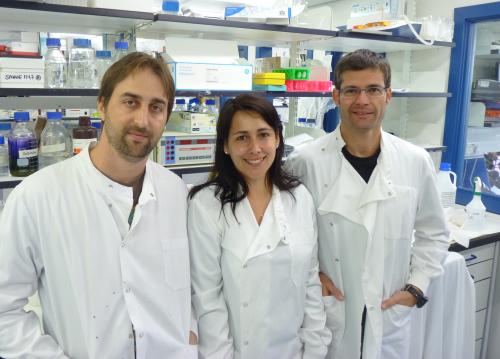
Ana Perez-Oliva working in collaboration with John Rouse's lab discovers new component regulating DNA damage responses
Ana Perez-Oliva a postdoc working in the Alessi lab on a collaborative project with Ian Hickson at Janssen Research & Development, was interested to explore the function of an unstudied deubiquitylase enzyme termed USP45 that is overexpressed in a significant number of human cancers.
This led Ana to uncover that the endogenous USP45 robustly co-immunoprecipitated with components known to play a major role in controlling DNA damage responses including ERCC1, XPF and SLX4 that previous work in John Rouse's lab had revealed form a complex. Ana then collaborated with Christophe Lachaud and Ivan Muñoz, postdocs in John Rouse's lab, to demonstrate that USP45 interacts directly with ERCC1 and not XPF or SLX4.
Ana also identified a short highly conserved acidic motif lying within the N-terminal non-catalytic region of USP45 that she demonstrated was essential for interaction with ERCC1. Ana pinpointed specific point mutations within this motif that ablated the ability of USP45 to associate with ERCC1, XPF and SLX4.
Ana next found that levels of ubiquitylated endogenous ERCC1 are markedly enhanced in USP45 knock-out cells that were generated by Piotr Szyniarowski. Moreover, in vitro studies, Ana was able to show that wild-type USP45, but not a USP45 mutant defective in ERCC1 binding, could efficiently deubiquitylate ERCC1. This suggests that ubiquitylated ERCC1 comprises a direct physiological substrate for USP45
Ana, Christophe, and Ivan, were then able to demonstrate that cells lacking USP45 are markedly hypersensitive to UV irradiation and other agents that induce DNA interstrand crosslinks, similar to cells lacking ERCC1. Furthermore, the repair of UV-induced DNA damage was markedly reduced in USP45 knockout cells. The translocation of ERCC1 to sites of DNA damage-induced subnuclear foci was also markedly impaired in USP45 knock-out cells.
USP45 was also found to localise to sites of DNA damage in a manner dependent upon deubiquitylase activity of USP45, but independent of its ability to bind ERCC1-XPF. This suggests that USP45 might play other roles or possess additional interactors or substrates at sites of DNA damage that need to be uncovered in future work.
In future work it will be important to understand how ERCC1 ubiquitylation is controlled and what its function is. It would also be interesting to explore whether inhibiting USP45 could be employed as a therapeutic strategy to induce sensitisation of cancer cells to chemotherapeutic platinum-based therapies that suppress growth and induce death of cancer cells by inducing DNA interstrand crosslinks. Moreover, if cancer patients displaying loss of function mutations in USP45 could be identified, the prediction would be that they would be sensitised to platinum based therapy. It may also be interesting to screen unclassified diseases caused by inefficient repair of interstrand DNA crosslinks where no gene has been assigned, such as Fanconi anemia patients, for mutations in USP45.
These data suggest that USP45 acts an important new regulator of XPF-ERCC1, crucial for efficient DNA repair. To read a copy of the paper describing this work click
This led Ana to uncover that the endogenous USP45 robustly co-immunoprecipitated with components known to play a major role in controlling DNA damage responses including ERCC1, XPF and SLX4 that previous work in John Rouse's lab had revealed form a complex. Ana then collaborated with Christophe Lachaud and Ivan Muñoz, postdocs in John Rouse's lab, to demonstrate that USP45 interacts directly with ERCC1 and not XPF or SLX4.
Ana also identified a short highly conserved acidic motif lying within the N-terminal non-catalytic region of USP45 that she demonstrated was essential for interaction with ERCC1. Ana pinpointed specific point mutations within this motif that ablated the ability of USP45 to associate with ERCC1, XPF and SLX4.
Ana next found that levels of ubiquitylated endogenous ERCC1 are markedly enhanced in USP45 knock-out cells that were generated by Piotr Szyniarowski. Moreover, in vitro studies, Ana was able to show that wild-type USP45, but not a USP45 mutant defective in ERCC1 binding, could efficiently deubiquitylate ERCC1. This suggests that ubiquitylated ERCC1 comprises a direct physiological substrate for USP45
Ana, Christophe, and Ivan, were then able to demonstrate that cells lacking USP45 are markedly hypersensitive to UV irradiation and other agents that induce DNA interstrand crosslinks, similar to cells lacking ERCC1. Furthermore, the repair of UV-induced DNA damage was markedly reduced in USP45 knockout cells. The translocation of ERCC1 to sites of DNA damage-induced subnuclear foci was also markedly impaired in USP45 knock-out cells.
USP45 was also found to localise to sites of DNA damage in a manner dependent upon deubiquitylase activity of USP45, but independent of its ability to bind ERCC1-XPF. This suggests that USP45 might play other roles or possess additional interactors or substrates at sites of DNA damage that need to be uncovered in future work.
In future work it will be important to understand how ERCC1 ubiquitylation is controlled and what its function is. It would also be interesting to explore whether inhibiting USP45 could be employed as a therapeutic strategy to induce sensitisation of cancer cells to chemotherapeutic platinum-based therapies that suppress growth and induce death of cancer cells by inducing DNA interstrand crosslinks. Moreover, if cancer patients displaying loss of function mutations in USP45 could be identified, the prediction would be that they would be sensitised to platinum based therapy. It may also be interesting to screen unclassified diseases caused by inefficient repair of interstrand DNA crosslinks where no gene has been assigned, such as Fanconi anemia patients, for mutations in USP45.
These data suggest that USP45 acts an important new regulator of XPF-ERCC1, crucial for efficient DNA repair. To read a copy of the paper describing this work click

